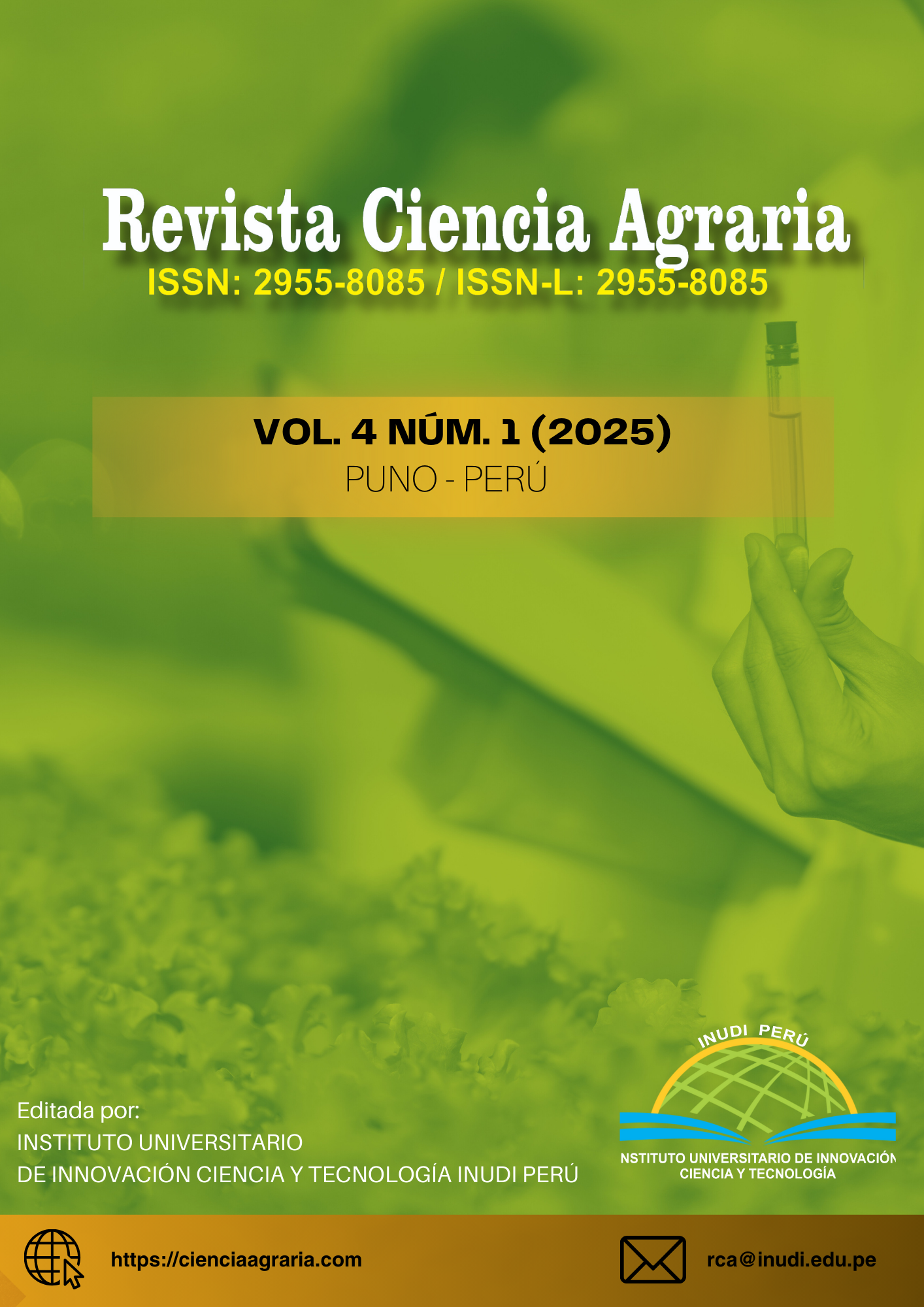Flood simulation in the La Llanga river (Peru) using hydrological modeling with HEC-HMS and HEC-GeoRAS
DOI:
https://doi.org/10.35622/Keywords:
basin, flood, simulation, model, La Llanga RiverAbstract
Floods are a phenomenon with low predictability in inter-Andean valleys. This study was conducted on the La Llanga River, located in the northern region of Peru (Cajamarca – Celendín), a tributary of the Marañón River, within the middle course of the Andes Mountains. The HEC-HMS and HEC-GeoRAS programs were used to model flood events, considering a return period of 50 years. The main issues identified include the loss of crops, livestock, housing, and human lives, highlighting the need to implement hydrological modeling systems that support the development of early warning mechanisms and raise awareness among the population and farmers living in riparian zones. The research is quantitative, descriptive, and non-experimental in nature. A 5,066-meter stretch of the main riverbed was analyzed, between the confluence with the Saraus River and its mouth at the Grande River (Llanguat). Grid systems and cross sections were applied to identify critical areas with greater flood depth, flow width, and velocity. The model results indicated flow velocities of up to 4.89 m/s, flood widths of up to 188 meters, and discharges exceeding 400 m³/s, with sediment and rock transport. These events have a significant impact on agricultural lands and tourism activities near the riverbed. It is concluded that a detailed understanding of fluvial dynamics is essential to reduce risks and optimize land use in vulnerable areas.
References
Araújo de Lucena, J., Suassuna de A. Wanderley, L., Ranulpho Da Silva, R., Carvalho Rocha, J., & Silva Nóbrega, R. (2016). Eventos extremos de lluvia y riesgo hidroclimático en zona de La Mata - Pernambuco/Brasil. Investigaciones Geográficas, (51), 81-90. https://doi.org/10.5354/0719-5370.2016.41819
Benito, G., Rico, M., Díez Herrero, A. Sánchez-Moya, Y., Sopeñar, A. & Thorndycraft, V.R. (20-25 de setiembre de 2004). Hidrología de paleocrecidas y seguridad de presas [Acta]. VIII reunión Nacional de Geomorfología, SEG y CSiC Madrid. https://shorturl.at/JcttF
Centro Nacional de Estimación, Prevención y Reducción del Riesgo de Desastres. (2014). Manual para la evaluación de riesgos originados por inundaciones fluviales. Perú, CENEPRED. https://shorturl.at/x6UbI
Demir, V. & Kisi, O. (2016). Flood Hazard Mapping by Using Geographic Information System and Hydraulic Model: Mert River, Samsun, Turkey. Advances in Meteorology, 2016(1), 1-9. https://doi.org/10.1155/2016/4891015
Devanand, M.R. and Kundapura, S. (2021). Flood inundation mapping of harangi river basin, kodagu, using Gis techniques and Hec-ras model. En M. Narasimhan, G. Varghese, G. Udayakumar & A. Kumar (Eds.), Trends in Civil Engineering and Challenges for Sustainability (pp. 665-678). Springer. https://link.springer.com/chapter/10.1007/978-981-15-6828-2_50
Elkhrachy, I. (2018). Assessment and Management Flash Flood in Najran Wady Using GIS and Remote Sensing. Journal of the Indian Society of Remote Sensing. 46(2), 297-308. https://doi.org/10.1007/s12524-017-0670-1
Hernández-Sampieri, R., Fernández, C., & Baptista, M. (2014). Metodología de la investigación. McGrawHill Education (6th ed.). https://shorturl.at/rQb4n
Gaagai, A., Aouissi, H. A., Krauklis, A. E., Burlakovs, J., Athamena, A., Zekker, I., ... & Chenchouni, H. (2022). Modeling and risk analysis of dam-break flooding in a semi-arid Montane watershed: a case study of the Yabous Dam, Northeastern Algeria. Water, 14(5), 767. https://doi.org/10.3390/w14050767
Gobierno Regional de Cajamarca. (2011). Estudio de suelos y capacidad de uso mayor del departamento de Cajamarca. https://zeeot.regioncajamarca.gob.pe/sites/default/files/INFSUELOSZEE091.pdf
Lohpaisankrit, W., Meon, G., & Tingsanchali, T. (2016). A framework of integrated hydrological and hydrodynamic models using synthetic rainfall for flash flood hazard mapping of ungauged catchments in tropical zones. Proceedings of the International Association of Hydrological Sciences, 373, 183-187. https://doi.org/10.5194/piahs-373-183-2016
López, R., Barragan, J. & Colomer, M. (2008). Predicción de la velocidad media del flujo en ríos de montaña. Ingeniería del agua, 15(2), 81-93. https://doi.org/10.4995/ia.2008.2928
Beguería, S., & Lorente, A. (1999). Distribución espacial del riesgo de precipitaciones extremas en el Pirineo aragonés occidental. Geographicalia, (37), 17-36. https://doi.org/10.26754/ojs_geoph/geoph.1999371398
Hortua Cortes, N. G. (2004). Geomorfología e hidrología, combinación estratégica para el estudio de las inundaciones en Florencia (Caquetá). Cuadernos de Geografía: Revista Colombiana de Geografía, (13), 81-101. https://dialnet.unirioja.es/servlet/articulo?codigo=4015328
Mekonnen, M., Melesse, A. M., & Keesstra, S. D. (2015). Spatial runoff estimation and mapping of potential water harvesting sites: A GIS and remote sensing perspective, Northwest Ethiopia. In Landscape dynamics, soils and hydrological processes in varied climates (pp. 565-584). Springer International Publishing. https://research.wur.nl/en/publications/spatial-runoff-estimation-and-mapping-of-potential-water-harvesti
Monsalve Sáenz, G. (1995). Hidrología en la ingeniería. Editorial Educativa. Bogotá. Colombia.
Ortega T., & Morales, C. (2002). Crecidas e inundaciones durante el invierno 2000-2001 en la ciudad de Valladolid y su entorno. Investigaciones Geográficas (España), (27), 35-64. https://doi.org/10.14198/INGEO2002.27.08
Rahman, B., Akmal, M., Muzaffarsyah, T., Muchlis, & Yunanda, R. (2024). The effectiveness of flood management system in aceh. Revista De Gestão Social e Ambiental, 18(6), 1-19. https://doi.org/10.24857/rgsa.v18n6-070
Romero, A., Guadalupe, E., & Blas, W. (2010). Estimado de descargas máximas en la microcuenca de Huaycoloro (Huachipa-Lima). Rev. del Instituto de Investigación FIGMMG-UNMSM, 13(25), 109-116. https://shorturl.at/bErg5
Sánchez González, D. (2011). Precipitaciones extremas y sus implicaciones en procesos de remoción en masa en la planificación urbana de Tampico, México. Cuadernos Geográficos, 48, 135-159. http://hdl.handle.net/10486/676670
Sarango, D., Velásquez, T., Rozas, G., & Gástelo, J. (2018). Estudio de máximas avenidas para la protección de zonas de posible inundación ubicada en el tramo La Oroya-40 km aguas abajo Cuenca del Río Mantaro. Revista Del Instituto de Investigación de La Facultad de Ingeniería Geológica, Minera, Metalurgica y Geográfica, 20(39), 27-38. https://doi.org/10.15381/iigeo.v20i39.14163
Urdiales, D., & Célleri, R. (2018). Forecasting of daily precipitation occurrence in an altitudinal gradient in southern Ecuador using a weather generator. Enfoque UTE, 9(3), 29-41. https://doi.org/10.29019/enfoqueute.v9n3.209
Velásquez, F., Cabrera, C., Alcántara, F., & Lucas, L. (2019). Pronóstico de precipitación sobre la cuenca aportante al embalse" La Esperanza" aplicando modelo climático HadCM3. Revista del Instituto de investigación de la Facultad de minas, metalurgia y ciencias geográficas, 22(43), 29-36. https://doi.org/10.15381/iigeo.v22i43.16683
Vélez Upegui, J. J., & Botero Gutiérrez, A. (2011). Estimación del tiempo de concentración y tiempo de rezago en la cuenca experimental urbana de la quebrada San Luis, Manizales. Dyna, 78(165), 58-71. https://www.redalyc.org/pdf/496/49622372006.pdf
Downloads
Published
Issue
Section
License
Copyright (c) 2025 Alejandro Alcántara Boza, Karen Gonzales-Plasencia, Francisco Velásquez-Intriago (Autor/a)

This work is licensed under a Creative Commons Attribution 4.0 International License.











